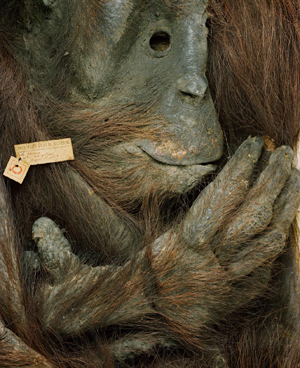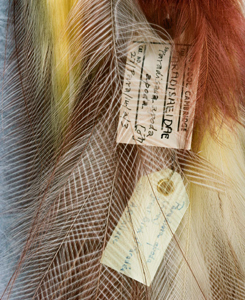By George Beccaloni
 I am often asked about Wallace's specimens, not only those in the Natural History Museum, London, where I work, but also those in other institutions. I have therefore decided to produce a brief overview of his surviving collections - where the specimens are now housed, plus an indication of what material is present. Anyone who knows anything about Wallace's collections will realise that they are highly dispersed across dozens of institutions worldwide, so they will appreciate what a big job it is going to be to compile a moderately comprehensive list. So please be aware that the list below is far from complete and will remain so for some time! If you spot anything that is missing then please email me at blaberus1@ntlworld.com
I am often asked about Wallace's specimens, not only those in the Natural History Museum, London, where I work, but also those in other institutions. I have therefore decided to produce a brief overview of his surviving collections - where the specimens are now housed, plus an indication of what material is present. Anyone who knows anything about Wallace's collections will realise that they are highly dispersed across dozens of institutions worldwide, so they will appreciate what a big job it is going to be to compile a moderately comprehensive list. So please be aware that the list below is far from complete and will remain so for some time! If you spot anything that is missing then please email me at blaberus1@ntlworld.com
INTRODUCTION
Wallace started to collect natural history specimens in 1841 whilst he was living near Neath in Wales. He wanted to be able to identify the plants he saw in the countryside when out doing his land surveying work, so he bought his first books on how to identify them and also began to form a reference collection of pressed specimens. In 1844 he met and became good friends with amateur entomologist Henry Walter Bates, who soon got Wallace interested in collecting British beetles. Wallace also started to collect butterflies and moths not long afterwards. In 1846 he bought a 28 drawer cedar and mahogany insect cabinet to house his beetles in, which is still owned by his descendents. [to be continued]
Wallace and his assistants collected specimens of about 5000 new animal (and a few fern) species in the Malay Archipelago. I based this on estimates that he and others who worked on his collections gave e.g. this from his book The Malay Archipelago:
"Nearly two thousand of my Coleoptera, and many hundreds of my butterflies, have been already described by various eminent naturalists, British and foreign; but a much larger number remains undescribed. Among those to whom science is most indebted for this laborious work, I must name Mr. F. P. Pascoe, late President of the Entomological Society of London, who has almost completed the classification and description of my large collection of Longicorn beetles (now in his possession), comprising more than a thousand species, of which at least nine hundred were previously undescribed, and new to European cabinets.
The remaining orders of insects, comprising probably more than two thousand species, are in the collection of Mr. William Wilson Saunders, who has caused the larger portion of them to be described by good entomologists. The Hymenoptera alone amounted to more than nine hundred species, among which were two hundred and eighty different kinds of ants, of which two hundred were new."
A good overview of what specimens Wallace collected in the Malay Archipelago can be found in the following paper by the late Donald Baker - CLICK HERE to download a pdf. A good paper by Fagan which discusses Wallace as a collector can be downloaded HERE. Images of some of his specimens can be seen HERE.
INSTITUTIONS WITH WALLACE SPECIMENS
UK
Booth Museum of Natural History, Brighton: A few butterfly specimens.
Cambridge University Herbarium: Fern specimens from Sarawak.
Dorset County Museum: c. 46 bird specimens from the Malay Archipelago and other places (1 from Para). These were part of Wallace's private collection and were acquired by Mr Parkinson Curtis from Wallace's widow after his death. They were left to the Museum in Parkinson Curtis's Will.
English Heritage, Down house: One female specimen of the long-armed chafer Euchirus longimanus in a storebox of Darwin's beetles which is on public display. This specimen was sent to Darwin by Wallace. Wallace wrote to Darwin on September 14th 1868 [?] "I send you by post a pair of the Euchirus longimanus. They are not quite perfect and are very rotten from being kept so long in open boxes but will perhaps answer your purpose." He went on to describe the sounds made by this species "Euchirus longimanus. (Amboyna, Ceram) when in motion makes a low hissing sound caused by protrusion and contraction of the abdomen. When seized it also produces a grating sound by rubbing the hind tibiae against the edges of the elytra." (CLICK HERE to see the letter). Darwin mentioned the stridulation in his book The Descent of Man.
Hunterian Museum, Glasgow: Beetle specimens. CLICK HERE for an example.
Linnean Society, London: Skin of a python. This was donated to the Society by Wallace's grandson John in 1958. It is reputed to be the skin of the snake which Wallace found in the roof of his hut on Amboyna (Ambon Island, Indonesia). In The Malay Archipelago he says "It was about twelve feet long and very thick, capable of doing much mischief and of swallowing a dog or a child."
Manchester Museum: A few birds. Unidentified Chrysomelidae beetles.
Natural History Museum, London: A huge selection of all of the groups of organisms he collected, including butterflies and birds from the Amazon, and insects, shells, amphibians, reptiles, birds, mammals and one or more ferns from the Malay Archipelago. A paper mentioning his bird specimens in the NHM can be seen HERE.
National Museum of Wales: c. 50 beetles, one butterfly and 5 bird skins.
Oxford University Museum of Natural History: Numerous insect specimens. An overview of these can be found listed HERE.
Royal Botanic Gardens, Kew: Palm specimens from the Amazon. Also CLICK HERE.
University Museum of Zoology, Cambridge: Quite a large number of bird specimens. Amongst these are five of Wallace's skins of Birds of Paradise were sold to the museum by Wallace's son William.
World Museum, Liverpool: Orangutan specimens from Sarawak: one folded skin and skull of a male, and one other skull of a now lost mounted specimen. These were from Lord Derby's collection. He purchased five skins and skulls and two skeletons of orangutans that Wallace collected in Sarawak.
Germany
Museum für Naturkunde, Berlin: Cicindelinae (tiger beetles) ex. the Hermann Schaum collection. Probably a lot of other material too.
The Netherlands
Naturalis, Leiden: 89 bird specimens (including type specimens) from the Malay Archipelago. See http://www.repository.naturalis.nl/document/44313
USA
California Academy of Sciences: c. 11 beetles from the Malay Archipelago ex. the Edwin C. Van Dyke collection.
Field Museum, Chicago: One or more bird specimens.
Australia
Macleay Museum, University of Sydney:
Museum Victoria, Melbourne: 192 birds (purchased from John Gould), 2 bats, 4 mammals plus numerous insects. An example of one of the birds can be SEEN HERE.
South Australian Museum, Adelaide:
Western Australian Museum, Perth: About 400 Hemiptera (true bugs) from the Malay Archipelago in the Francis Buchanan White Collection.
Singapore
Lee Kong Chian Natural History Museum (formerly Raffles Museum): One bird specimen - a flycatcher.
ACKNOWLEDGEMENTS
Very many thanks to the following for useful information: Kate Hebditch (Dorset County Museum); Norm Penny (CAS); Rolf Schmidt (Museum Victoria); Fred Edwards (UK); Julian Carter (National Museum of Wales); Bernd Jaeger (Museum für Naturkunde).
REFERENCES


